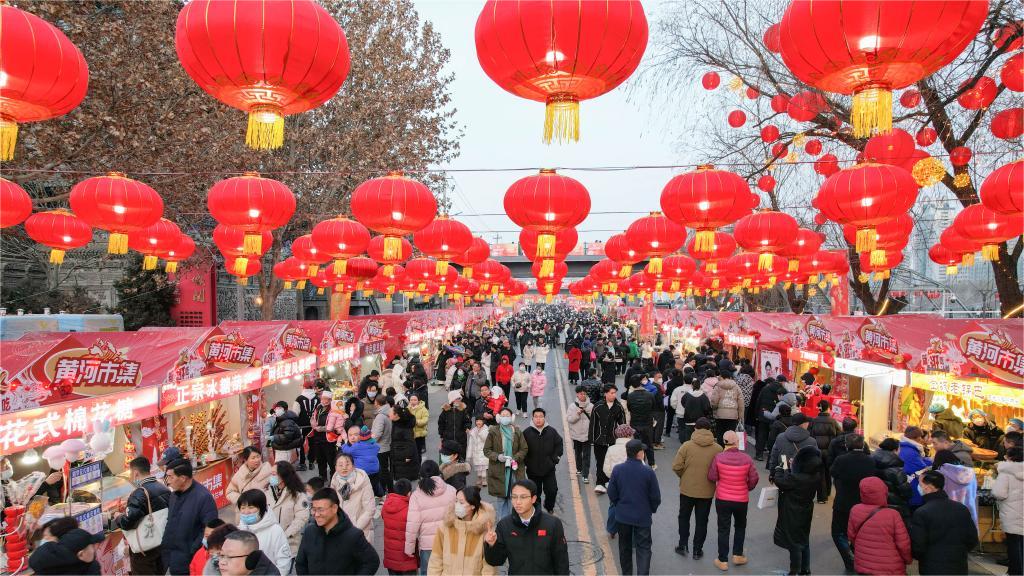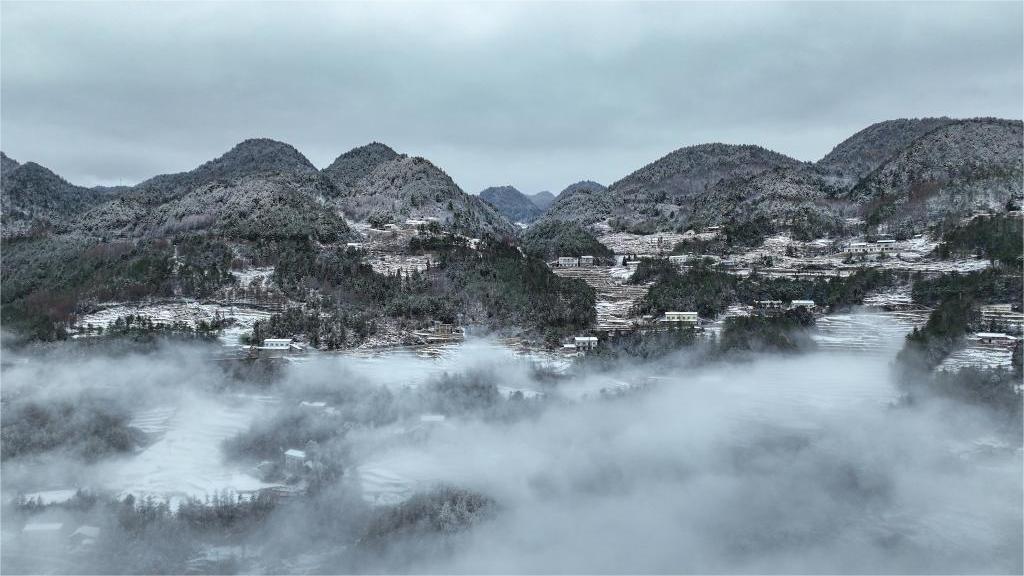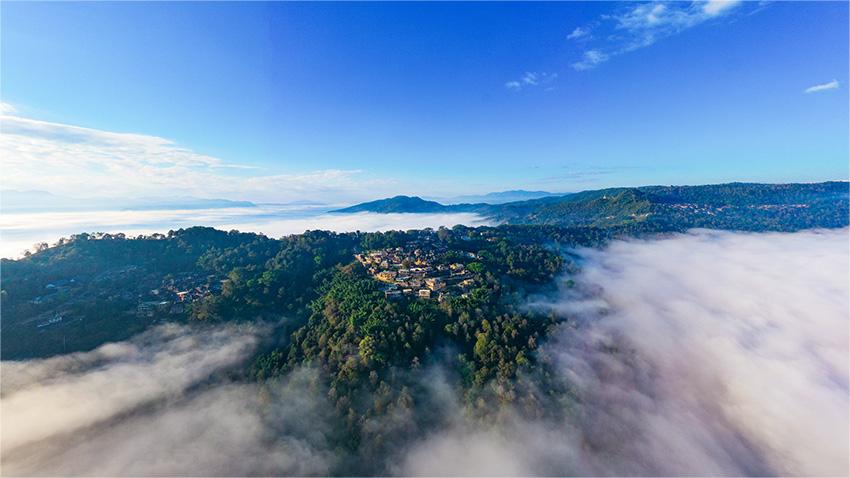Thousands flock to Beijing's rejuvenated temple fairs

Visitors to the Taoist Dongyue Temple fair in Chaoyang district enjoy folk performances including zhongfan, a flagpole balancing act with amazing acrobatic feats, and lion and dragon dances. [JIANG DONG/CHINA DAILY]
A strong sense of nostalgia permeated temple fairs held across Beijing during the Spring Festival holiday this year. Children could be seen sitting on the shoulders of their fathers, mothers pushed baby strollers, and long lines of people waited to buy treats from food stalls.
After a four-year hiatus due to COVID-19, the fairs — which are an integral part of the festival — reopened in Beijing this year.
Major temple fairs such as those at Ditan, Longtanhu and Daguanyuan parks attracted large crowds during the weeklong holiday.
Over 2.6 million people went to such fairs in Beijing from Feb 10 to 13, according to media reports. Due to the strong attendance and positive feedback from tourists, the fairs, scheduled to run from Feb 10 to 14, were extended to Feb 16.
Lu Baogang, 59, has been performing shadow plays at the city's Spring Festival temple fairs for 40 years.
Lu is a member of the Beijing Shadow Show Troupe, which staged four daily shows at Daguanyuan Park from Feb 10 to 16.
Shadow play, also known as shadow puppetry, is a traditional Chinese art form that combines music, storytelling and puppets. It began to take shape in the Western Han Dynasty (206 BC-AD 24), and reached its peak in the Tang (618-907) and Song (960-1279) dynasties.
During a performance, puppeteers manipulate colorful silhouette figures made from leather or paper, by using rods. The figures create the illusion of moving images on a translucent cloth screen illuminated from behind.
"There is a saying about art troupes performing Chinese traditional art forms," Lu said. "If we didn't have any performances at temple fairs, which mark the beginning of a new year, it will be a difficult year. That's why temple fairs are very important for us performers."
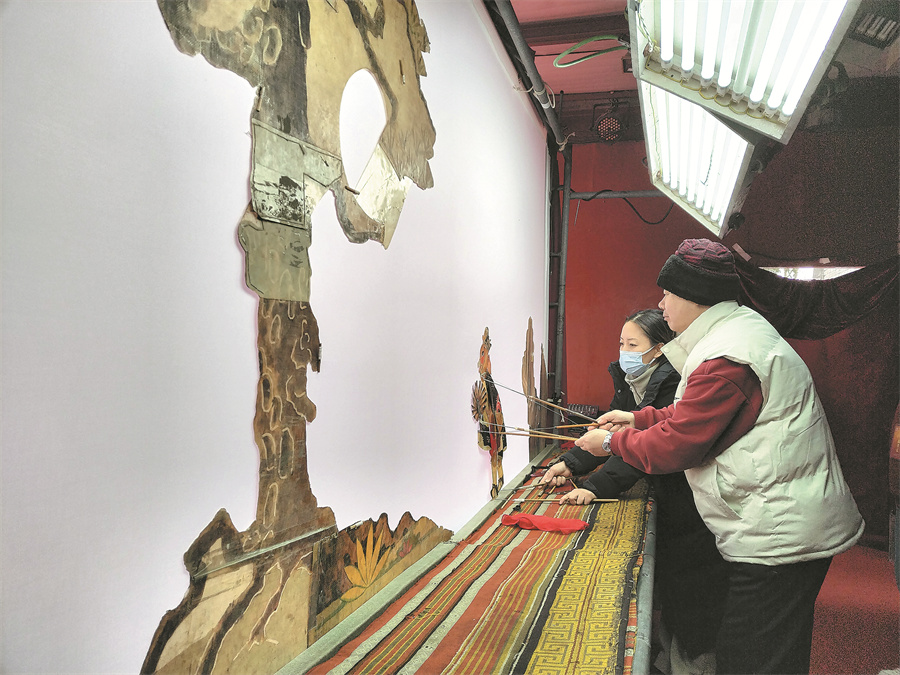
Lu Baogang performs a shadow play at the capital's Daguanyuan temple fair. [Photo/CHINA DAILY]
Out of the shadows
Lu recently retired as head of the troupe, which was founded in 1957, and is dedicated to preserving and popularizing the art form.
He recalls vividly when their show was canceled due to the pandemic. "We had already set up the stage and our first show was due to open the next morning when we were told that the temple fair was canceled due to the pandemic," said Lu. "After four years, we are finally able to present shows at temple fairs again."
Born and raised in a Beijing hutong, Lu is the fifth generation of his family involved in shadow plays. When he was 15 years old, his father died of a heart attack. Sadly, his father had been appointed director of the troupe days before he passed away. As the only son, Lu dropped out of school and started working with the troupe.
After learning last year that temple fairs were to restart in Beijing, Lu was excited at the news and decided to reinterpret a classic story. Titled Fan Lihua, the play tells the story of Fan, a legendary female general during the Tang Dynasty.
According to Lu, Fan Lihua is an old show from the troupe's repertoire. When Lu decided to perform his own adaptation of Fan Lihua, he invited a young composer, Bai Qiutong, to do the music for the 50-minute show.
Bai used over 10 traditional Chinese musical instruments to write music for Fan Lihua, such as the sanxian (a three-stringed lute), the sihu (a four-stringed fiddle) and instruments from the ruan (plucked instrument) family. She also used flutes and percussion instruments, which are widely featured in Peking Opera.
"I came to the temple fair at Daguanyuan Park on Feb 10, the first day of Lunar New Year, and I was overwhelmed by the huge crowds," said Bai, a Beijing native aged in her 20s. "The show fitted the atmosphere of Spring Festival, with a story about a female hero and joyful, energetic music."

A martial arts performance at the Taoist Dongyue Temple fair. [JIANG DONG/CHINA DAILY]
Lu was pleased the show crossed different generations.
"This year, people came to our stage and stayed for the whole show," he said. "Our show is new and fun for kids. People haven't had the experience of a temple fair for a long time and they wanted to enjoy every minute," said Lu.
The troupe also staged other shows, including an adaptation of the classic Chinese novel Journey to the West.
Drawing on his own childhood, Lu remembers the thrill of going to temple fairs with his parents and four older sisters after partaking in Chinese New Year traditions, such as making dumplings and staying up all night on New Year's Eve.
"It was very cold and often snowy. Going to a temple fair was one of the most exciting things to do for children since we could have lots of snacks, candies and new toys," he said.
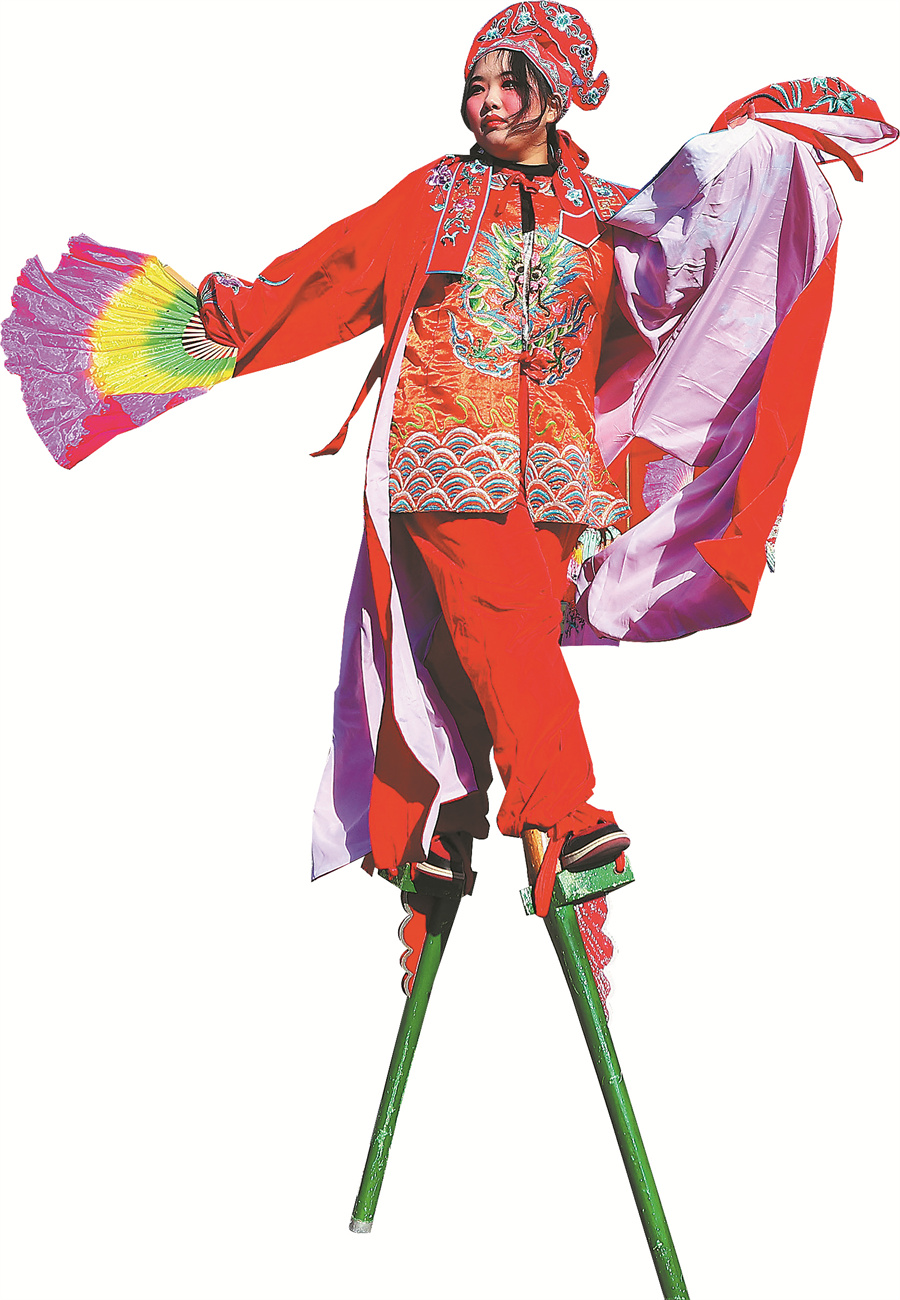
An performer walks on stilts at the Taoist Dongyue Temple fair in Beijing. [JIANG DONG/CHINA DAILY]
Acrobatic skills
Major temple fairs held during the holidays also highlighted Beijing's history and culture. Changdian temple fair held around Hepingmen and Hufangqiao streets, dates back over 400 years, according to the Beijing government. As one of the biggest and oldest temple fairs in the capital, it attracts a large number of people with stalls selling old books, antiques, traditional Chinese paintings and calligraphy.
The fair is located near Tianqiao commercial area, a former hub for folk art and small businesses. Today, folk artists still gather at Changdian temple fair to display their skills, such as xiangsheng, or crosstalk, a comedic act that is performed as a dialogue between two performers or as a solo monologue, pingshu, a form of storytelling, and martial arts.
Zhu Yi is head of the publicity department of the Beijing Folklore Museum located at the Taoist Dongyue Temple in Chaoyang district. The museum organizes the Beijing Folk Art Festival, which is in its 13th year and part of the temple's fair. It saw strong attendances this year.
"The number of people (coming to the temple fair) broke records attracting over 10,000 visitors every day," said Zhu.
Apart from lion and dragon dances, the fair this year also featured zhongfan, a flagpole balancing act with amazing acrobatic feats. Acrobats throw and balance bamboo poles 10-meters long and weighing about 50 kilograms, using their hands, backs, jaws and foreheads. The poles have large flags decorated with images of clouds and dragons attached to them.
Zhongfan originated in the Tang and Song dynasties and was traditionally the major attraction at temple fairs, Zhu said.
In 2007, the museum helped revive interest in the art form by organizing a skills competition, which included zhongfan, for acrobatic troupes in Beijing. Thirteen teams displaying expertise in lion dancing, zhongfan and gaoqiao, or walking on stilts, stood out from the competition. They were organized into a performance troupe by the museum.
"During this year's temple fair, we took those folk artists to perform not only at Dongyue Temple but also at four different spots near the temple," Zhu said. "They attracted a large number of admirers as they paraded for about two kilometers along streets while showcasing their skills."
During the pandemic-induced hiatus, the museum put folk art performances online.
However, while it was a good compromise it did not match the immediacy of watching a live performance, Zhu said. "When you are watching a show live you feel like you are a part of the story. The feeling is stronger during Spring Festival."
For the upcoming Lantern Festival, which marks the end of Spring Festival and falls on Feb 24, Dongyue Temple will continue its fair. Visitors can enjoy viewing colorful lanterns and eating treats such as yuanxiao, glutinous rice balls with sweet fillings.
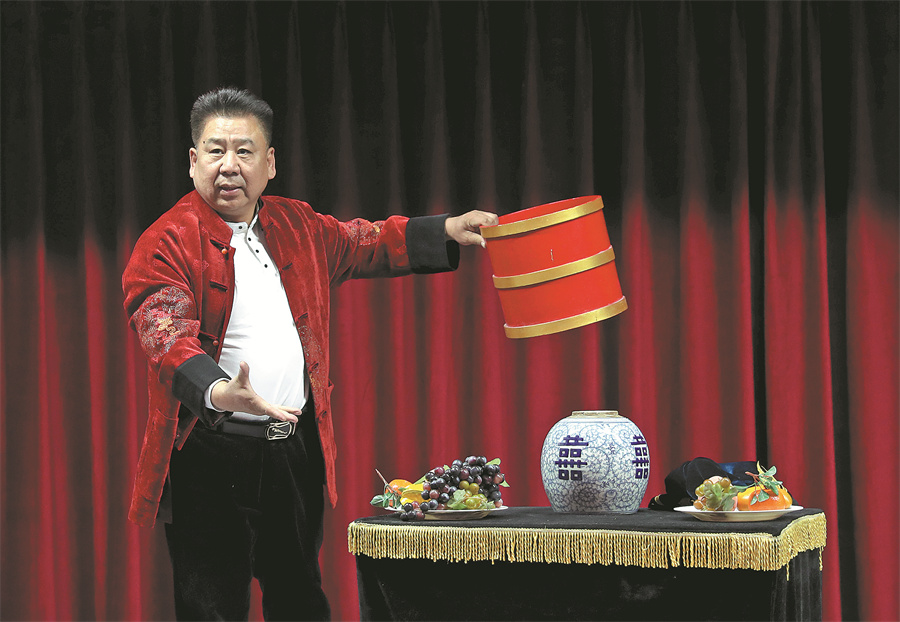
Tian Xueming, a folk artist, does magic tricks at a temple fair in Beijing's Deshengmen area. [ZOU HONG/CHINA DAILY]
Tradition survives
Tian Xueming, a folk artist born and raised in Beijing, launched an indoor temple fair in the capital during Spring Festival this year.
Every day, hundreds of people visited his indoor fair, which covers about 3,000 square meters in a building in Deshengmen area. He hopes to make the venue a permanent destination for tourists, offering folk art performances every day.
Tian, 60, has worked at Beijing temple fairs since 1996 and performs magic tricks in addition to qigong and tai chi. He learned martial arts when he was a child, and despite his father's objections pursued a career as a folk artist.
"I was amazed by folk art when I went to temple fairs with my parents and my older brother as a kid. I didn't want to leave until the performers called it a day," said Tian.
Traditional temple fairs are where people pray for good luck for the new year and have fun with their families, he added. "As a performer, I love seeing children riding on their parents' shoulders, holding a windmill toy in one hand and a tanghulu (candied haws on a stick) in another hand."
In 1989, Tian enrolled at a performing arts school to learn Hebei Bangzi, a traditional Chinese opera. Two years later he began training in more folk arts, such as magic tricks, lion dances and bian lian, a face-changing show.
In 2000, Tian founded a school to keep those folk arts alive. He worries that such skills and traditions are fading away as the younger generation has more entertainment options.
"Today, life is much better than when I was a child. We have phones to call our families in a different city or even a different country. We don't need to wait for Lunar New Year to buy new clothes or eat food we want, such as dumplings. However, the core of Spring Festival is the same; it is about family and memories," said Tian.
Photos
Related Stories
- Artists perform during concert themed "Happy Chinese New Year" in Hesperange, Luxembourg
- Cross-border sightseeing trips during Spring Festival holidays rebound to reach 90% of 2019 levels
- Fair attracts tourists during Lunar New Year celebrations in east China's Qingdao
- Traditional Chinese lanterns illuminate festivities globally
- People across China enjoy Spring Festival
- Concert in celebration of Chinese Lunar New Year staged in San Francisco
Copyright © 2024 People's Daily Online. All Rights Reserved.







